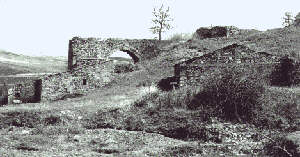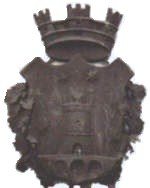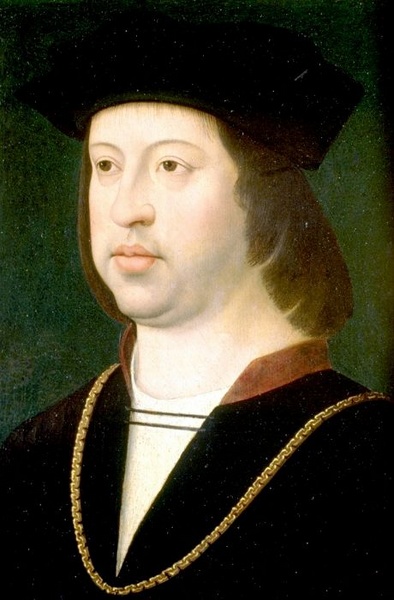
 Monday 17 November 2025 5:20
Monday 17 November 2025 5:20
Trevico
| Condividi |

|

|

|

|
The Baronia of Vico |
Origin of name |
The emblem |
The Diocese
The feudal lords | The Marquesas | The Bishops | The Mayors
The feudal lords | The Marquesas | The Bishops | The Mayors
The Baronia
 In 37 aC, the Roman poet Horace, on his way from Rome to Brindisi with Maecenas, Cocceius
Capito, Nerva Prozio and Vario, halted in an inn near Trivici, identified by posterity in the locality
Tavern of the nuts, which was probably at the intersection of two streets, the Egnatia for Apulia and the Appia to
Brindisi. In Satire V, Libro1, the poet describes a night of suffering from the smoke coming out of the fire
wet and green boughs. This, after waiting in vain until midnight a young woman.
In 37 aC, the Roman poet Horace, on his way from Rome to Brindisi with Maecenas, Cocceius
Capito, Nerva Prozio and Vario, halted in an inn near Trivici, identified by posterity in the locality
Tavern of the nuts, which was probably at the intersection of two streets, the Egnatia for Apulia and the Appia to
Brindisi. In Satire V, Libro1, the poet describes a night of suffering from the smoke coming out of the fire
wet and green boughs. This, after waiting in vain until midnight a young woman.
Incipit ex illo montis Apulia notos
ostentare mihi, quos torret Atabulus et quos
numquam erepsemus, nisi nos vicina Trivici
villa recepisset lacrimoso non sine fumo,
udos cum foliis ramos urente camino.
From here begins the Puglia begin to show
known mountains, that the Scirocco burning and that
we would never have crossed, if there had hosted a
inn near Trevico, full of smoke from us eyes tear,
while the fire burned wet branches with leaves.
Besides this memory of Horace, which suggests Trevico pre-Christian origin, we have no precise information about his
birth.
The presence of the necropolis found in Carife, Castel Baronia and Flumeri, trace the origin of Baronia of Vico
around the fourth century aC, when the entire Irpinia was inhabited by the Samnites. In this period, the territory of
Baronia was constantly plundered by the Romans after the wars with Rome. Subsequently, it was joined to
Hall of Aeclanum which followed the events up to 662 dC, when it was destroyed by Constans II
of Orient in combating between the Longobards and Byzantines. There followed a period in which the territory was affected by the domination
of Longobard and Byzantine. With the arrival of the Normans between 1057 and 1061, and the dispossession of the Byzantines, was born
the Baronia of Vico. In fact, at the behest of Roberto the Guiscardo, all municipalities in the area were assigned to a single
gentleman, his nephew Gradilone, resident in the castle of Vico, at base of which were built the fortresses of Carife,
Castello, S. Nicola, S. Sossio and Zungoli which soon became Casali of Vico ensuring its defense.
The same Robert, however, had to return from Calabria in 1078 to combat the nephew Gradilone who had
participated in an insurrection against him. The Duke was able to gain control of the city and made blind the
nephew in the castle of Vico.
In 1122, during a revolt against the Normans in Flumeri, the rebels killed the then owner of Trevico, Richard,
son of Guarino Formaro. To this notice William, Duke of Apulia, son of Robert Guiscard, reacted by killing
all his murderersand naming the first Baron of Baronia of Vico's son Richard, Richard II de Formaro, which
was established in the castle of Flumeri. Assigned to it were the fiefs of Trevico, Contra and Flumeri.
 To Richard was succeeded in 1150, the son Roger by which of they were attached to the fief St. Agata di Puglia and
Ascoli Satriano. In 1190 the feud passed to his son Robert and then, in 1239, to the latter's son, Richard Benedetto,
up to 1266, when succeeded the family Angioina with the kingdom of Charles of Angiò. This gave the feud first
to Knight French Provencal Adam de Bruveriis, in 1267, in return for services done during the war against
Manfredi, then, in 1296 to Ada de Bruveriis, John and Ugo Scotti. This died, the feud passed in 1314 to Mark
Aiossa.
To Richard was succeeded in 1150, the son Roger by which of they were attached to the fief St. Agata di Puglia and
Ascoli Satriano. In 1190 the feud passed to his son Robert and then, in 1239, to the latter's son, Richard Benedetto,
up to 1266, when succeeded the family Angioina with the kingdom of Charles of Angiò. This gave the feud first
to Knight French Provencal Adam de Bruveriis, in 1267, in return for services done during the war against
Manfredi, then, in 1296 to Ada de Bruveriis, John and Ugo Scotti. This died, the feud passed in 1314 to Mark
Aiossa.
In the first half of the fourteenth century, King Robert of Angiò gave the Baronia of Vico with its hamlets (Carife, St. Nicola of
Ripa and Ospedale) to his wife, Queen Sancha, which, in 1343, sold it to Raymond Del Balzo of count of Avellino,
who left heir by testament his nephew Niccolò Orsini, Count of Nola, who succeeded in August 1375.
 During the domination of Angiò, the Baronia reached maximum power and expansion, including as many as 18 between hamlets,
cities and castles: Carife, S. Nicola de Ripa, Ospedale, S. Marzano, S. Sossio, Acquara, S. Giovanni, Castello, Avezano,
S. Giacomo, Accadia, Montaguto, S. Bartolomeo and Flumeri. After the defeat of Durazzeschi, the lord of
Trevico, a certain Giovanni Pipino, left the area leaving it at the mercy of criminal gangs, so that the
Queen Joanna I, in 1344, exonerated the Baronia from paying taxes for that year.
During the domination of Angiò, the Baronia reached maximum power and expansion, including as many as 18 between hamlets,
cities and castles: Carife, S. Nicola de Ripa, Ospedale, S. Marzano, S. Sossio, Acquara, S. Giovanni, Castello, Avezano,
S. Giacomo, Accadia, Montaguto, S. Bartolomeo and Flumeri. After the defeat of Durazzeschi, the lord of
Trevico, a certain Giovanni Pipino, left the area leaving it at the mercy of criminal gangs, so that the
Queen Joanna I, in 1344, exonerated the Baronia from paying taxes for that year.
In 1384, Omaco Lombardo, combating courageously under the names of Niccolò Orsini, Count of Nola, was decorated by
King Charles III of Durazzo with the title of Baron of Trevico and Flumeri. The two baronies included Flumari, Zungoli,
Pulcarino (current Villanova del Battista), the town of Vico and its hamlets, Vallata, Castello, Carife and St. Nicola.
In 1390 the Baronia passed to Peter Macedonio, for his fidelity to Louis of Taranto, in the war against Durazzo
but, when they regained prevail, the Baronia came back to Del Balzo. On July 2, 1393, King Ladislao of Naples,
allowed to Nicola Orsini to divide the feuds among his sons. The feud involving the Baronia of Vico went to Raymond
Orsini, known as Raimondello, who added to his name even that to Del Balzo in memory of her grandmother's Sveva
Del Balzo. At his death in 1406, the feud is not passed immediately to the eldest son Giovanni Antonio because
the marriage of his mother, Maria d'Enghien, with King Ladislao that incorporated all its domains in the State Property.
In 1418 the feuds were returned to Mary that gave to Giovanni Antonio everyone of his father, including
baronies of Flumeri and Trevico. In 1421, an agreement between Mary and her children on the division of feuds assigned to
Gabriel of Balzo the two baronies, which in 1454 were donated to the latter's daughter, Maria Donata Orsini, wife
of Pirro Del Balzo. On the occasion of the marriage of second daughter Isabella with Frederick of Aragon, in 1482 Maria Donata
gave his daughter several cities including Vico with its houses, Lacedonia, Flumeri and Vallata.
 In 1487, the King of Naples, Ferdinand of Aragon, gave to his son, Frederick I of Aragon, all the feuds confiscated at
Del Balzo and his family because of the rebellion of Pirro. In 1497 Frederick of Aragon gave the city of Vico and
Montefusco lands, with the Customs of Flumeri Bufante, Pulcarino, Vallata, Castello, Carife and Zungoli, to Giovanni Borgia
of Aragon, Duke of Candia and Sessa, Prince of Theano, in reward for services rendered.
In 1487, the King of Naples, Ferdinand of Aragon, gave to his son, Frederick I of Aragon, all the feuds confiscated at
Del Balzo and his family because of the rebellion of Pirro. In 1497 Frederick of Aragon gave the city of Vico and
Montefusco lands, with the Customs of Flumeri Bufante, Pulcarino, Vallata, Castello, Carife and Zungoli, to Giovanni Borgia
of Aragon, Duke of Candia and Sessa, Prince of Theano, in reward for services rendered.
In 1507, King Ferdinand the Catholic, gave as gift the Baronia of Flumari and Trevico to his Great Captain Gonsalvo
Fernandez de Corduba, duke of Sessa whose daughter Elvira, in 1515 passed to his son, Consalvo Fernandez de Corduba,
Flumeri, S. Nicola, Castello and Acquara that became a new Baronia with Flumeri as capital, while the city of
Vico with its hamlets, S. Sossio and Zungoli were sold to Francis Loffredo I, called Cecco, Patrick Neapolitan,
President of the Royal Council of the Sacred Kingdom of Naples from 1540 to 1541, Vice Protonotary of the Kingdom of Naples. From the
feud of Baronia were born, so, the Marquis of Trevico, Vallata and Carife, the Duchy of Flumeri, Castello and S. Nicola.
In 1547 Trevico passed to son of Francesco, Ferdinando Loffredo that, in 1548, became the 1st Marquis of Trevico and
Lord of S. Sossio and Zungoli and remained in the hands of Loffredo until the nineteenth century when, in 1815, were abolished
feudal rights that forced barons and marquises to return to citizens the state property usurped in the before centuries.
The unity of Baronia and related feudal privileges, then began to falter, giving rise to
phenomenon of autonomy, which led many hamlets to become autonomous municipalities: first Anzano (1810), then Scampitella
(1948) and finally Vallesaccarda (1958). The territory of Trevico so definitely was reduced by approximately 100 sq. km to
current size of about 10,5 sq. km.
Currently the Baronia includes the municipalities of Trevico, Vallesaccarda, Scampitella, Vallata, Carife, Castel Baronia, S.
Nicola Baronia, S. Sossio Baronia and Flumeri, with an area of ??approximately 180 square kilometers enclosed in a delta fluvial
delimited to north by the river Fiumarella, to east by the river Calaggio, to south and west from the Valley of Ufita and the homonymous
river, and has a population of about 15.000 inhabitants (2010).
The Baronia of Vico |
Origin of name |
The emblem |
The Diocese
The feudal lords | The Marquesas | The Bishops | The Mayors
The feudal lords | The Marquesas | The Bishops | The Mayors
Contact | Copyright | Privacy Policy
